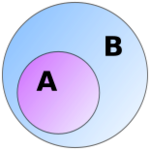Inclusion map
In mathematics, if [math]\displaystyle{ A }[/math] is a subset of [math]\displaystyle{ B, }[/math] then the inclusion map (also inclusion function, insertion,[1] or canonical injection) is the function [math]\displaystyle{ \iota }[/math] that sends each element [math]\displaystyle{ x }[/math] of [math]\displaystyle{ A }[/math] to [math]\displaystyle{ x, }[/math] treated as an element of [math]\displaystyle{ B: }[/math] [math]\displaystyle{ \iota : A\rightarrow B, \qquad \iota(x)=x. }[/math]
A "hooked arrow" (U+21AA ↪ RIGHTWARDS ARROW WITH HOOK)[2] is sometimes used in place of the function arrow above to denote an inclusion map; thus: [math]\displaystyle{ \iota: A\hookrightarrow B. }[/math]
(However, some authors use this hooked arrow for any embedding.)
This and other analogous injective functions[3] from substructures are sometimes called natural injections.
Given any morphism [math]\displaystyle{ f }[/math] between objects [math]\displaystyle{ X }[/math] and [math]\displaystyle{ Y }[/math], if there is an inclusion map [math]\displaystyle{ \iota : A \to X }[/math] into the domain [math]\displaystyle{ X }[/math], then one can form the restriction [math]\displaystyle{ f\circ \iota }[/math] of [math]\displaystyle{ f. }[/math] In many instances, one can also construct a canonical inclusion into the codomain [math]\displaystyle{ R \to Y }[/math] known as the range of [math]\displaystyle{ f. }[/math]
Applications of inclusion maps
Inclusion maps tend to be homomorphisms of algebraic structures; thus, such inclusion maps are embeddings. More precisely, given a substructure closed under some operations, the inclusion map will be an embedding for tautological reasons. For example, for some binary operation [math]\displaystyle{ \star, }[/math] to require that [math]\displaystyle{ \iota(x\star y) = \iota(x) \star \iota(y) }[/math] is simply to say that [math]\displaystyle{ \star }[/math] is consistently computed in the sub-structure and the large structure. The case of a unary operation is similar; but one should also look at nullary operations, which pick out a constant element. Here the point is that closure means such constants must already be given in the substructure.
Inclusion maps are seen in algebraic topology where if [math]\displaystyle{ A }[/math] is a strong deformation retract of [math]\displaystyle{ X, }[/math] the inclusion map yields an isomorphism between all homotopy groups (that is, it is a homotopy equivalence).
Inclusion maps in geometry come in different kinds: for example embeddings of submanifolds. Contravariant objects (which is to say, objects that have pullbacks; these are called covariant in an older and unrelated terminology) such as differential forms restrict to submanifolds, giving a mapping in the other direction. Another example, more sophisticated, is that of affine schemes, for which the inclusions [math]\displaystyle{ \operatorname{Spec}\left(R/I\right) \to \operatorname{Spec}(R) }[/math] and [math]\displaystyle{ \operatorname{Spec}\left(R/I^2\right) \to \operatorname{Spec}(R) }[/math] may be different morphisms, where [math]\displaystyle{ R }[/math] is a commutative ring and [math]\displaystyle{ I }[/math] is an ideal of [math]\displaystyle{ R. }[/math]
See also
- Cofibration
- Identity function – In mathematics, a function that always returns the same value that was used as its argument
References
- ↑ MacLane, S.; Birkhoff, G. (1967). Algebra. Providence, RI: AMS Chelsea Publishing. p. 5. ISBN 0-8218-1646-2. "Note that “insertion” is a function S → U and "inclusion" a relation S ⊂ U; every inclusion relation gives rise to an insertion function."
- ↑ "Arrows – Unicode". Unicode Consortium. https://www.unicode.org/charts/PDF/U2190.pdf.
- ↑ Chevalley, C. (1956). Fundamental Concepts of Algebra. New York, NY: Academic Press. p. 1. ISBN 0-12-172050-0. https://archive.org/details/fundamentalconce00chev_0.
 |


